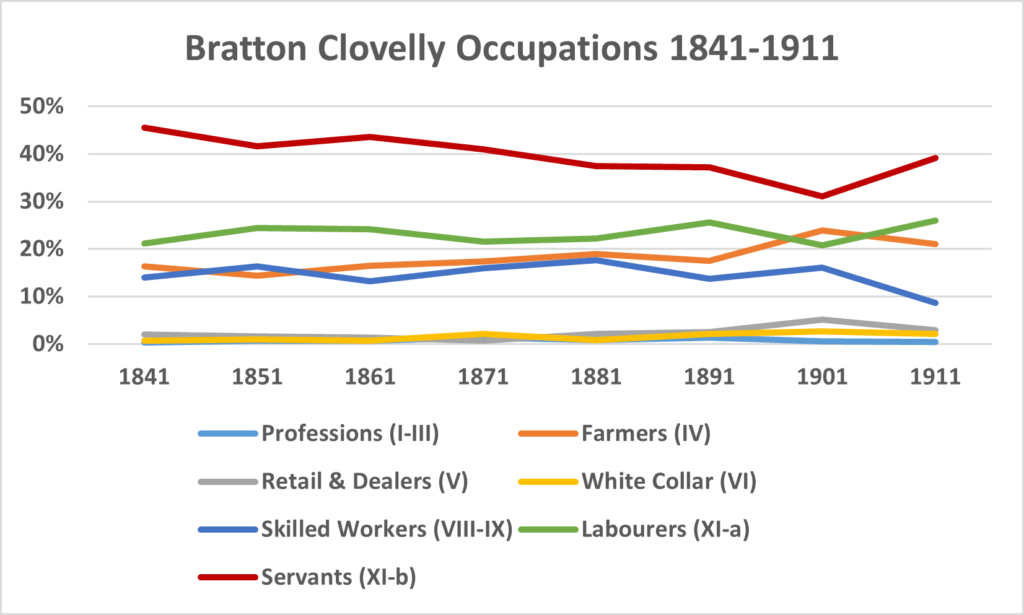This page provides a brief overview of occupations in the parish. To find out more about the young servants, the largest occupational group in Bratton Clovelly, see the Servants page.
Overview of Bratton Clovelly Occupations, 1841 to 1911
The following charts are derived from the census ‘Occupation’ field with some grouping of like occupations. The 1851 occupation statistics represent 314 (45%) of the total 696 Bratton Clovelly residents, the remainder being made up of 28 scholars (4%) and another 354 (51%) with no occupation specified. The 1911 occupation statistics represent 253 (61%) of the total 413 residents, the remainder being 46 (11%) scholars and another 114 (28%) with no occupation specified.
There are some obvious differences between the two censuses. Given that the population had decreased significantly, percentage values are the most useful for comparisons. Some of the differences include:
- The percentage of the population working increased substantially, reflecting a large reduction in the number of children in the parish through this timeframe.
- Both percentage-wise and actually, there are more farmers perhaps reflecting broader access to land ownership.
- There are many fewer servants, reflecting the much smaller population and possibly the impact of industrialisation.
- There are many more children identified as scholars, reflecting increased access to education and changing legislation.
- There are many more women listing occupations. Potential explanations might be the loss of income from children due to changes in education legislation, increasing economic pressures in the agricultural sector, changing social norms or impacts of modernisation on the workload within their own households.
- There are more transport workers for roads and railways (platelayers).
- Some occupations no longer appear such as wool spinners, thatchers and those identified as paupers, but new ones have appeared.
 Click to enlarge Click to enlarge |
 Click to enlarge Click to enlarge |
However, if the occupations are grouped into major categories, a different picture emerges that highlights the fairly remarkable stability of the adult workforce. A simplified version of Watts’ elevenfold occupational classifications was applied for this part of the study. The classification scheme defined by M. R. Watts in his book The Dissenters (1995) was chosen because his descriptions identify virtually all occupations found in the Bratton Clovelly censuses. The scheme also clearly delineates the main classes of workers found in the parish and there was some economic basis to the classifications although representative wages were from the slightly earlier period of the 1830s. The scheme was first applied to all residents of the parish with an occupation in order to provide a profile for the parish as a whole in the 1841, 1871 and 1911 censuses. Throughout the study period, the parish was one of farmers, craftsmen (skilled workers) and agricultural labourers, with a large base of young workers employed as servants prior to marriage.
Overall, the percentage of heads of household who were farmers or agricultural labourers increased from 1841 to 1911. Essentially, while the parish reduced dramatically in population, the number of farms was the primary determinant of the number of adult workers needed in these occupations. On the other hand, the demand for skilled workers such as carpenters and blacksmiths dropped significantly in this timeframe due to the steep population drop. In terms of overall composition though, it was the young servants, the largest part of the Bratton Clovelly workforce throughout this timeframe, who absorbed most of the impact of the sharp decrease in population and enabled the adult workforce to remain relatively stable.

